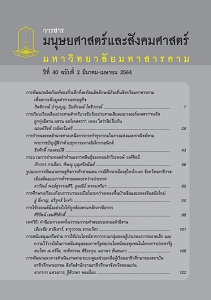การสนับสนุนเครือข่าย การใช้ประโยชน์จากการรวมกลุ่มของผู้ประกอบการขนาดเล็ก และความไว้วางใจในการสนับสนุนของภาครัฐต่อประโยชน์ของชุมชนในโครงการประชารัฐ
Main Article Content
บทคัดย่อ
บทคัดย่อ
ปัญหาของหาบเร่และแผงลอยรวมทั้งชุมชนแออัดในกรุงเทพมหานครฯ ส่งผลต่อปัญหาสิ่งแวดล้อมและคุณภาพชีวิตของชุมชนที่มีอยู่จำนวนมาก การดำเนินโครงการประชารัฐ ที่ประกอบด้วย ภาครัฐ สังคม ชุมชน และผู้ประกอบการขนาดเล็ก จึงเป็นทางเลือกหนึ่งในการแก้ปัญหา การศึกษานี้เลือกกลุ่มตัวอย่างจำนวน 200 หน่วย จากผู้ประกอบการขนาดเล็กใน 10 โครงการ ด้วยการใช้แบบสอบถาม เพื่อประเมินปัจจัยความสำเร็จและจุดอ่อนเพื่อนำไปสู่การพัฒนาต้นแบบที่สมบูรณ์ ตัวแบบกรอบแนวคิดที่สังเคราะห์ ประกอบด้วย การสนับสนุนเครือข่าย การใช้ประโยชน์จากการรวมกลุ่มของผู้ประกอบการขนาดเล็ก และความไว้วางใจในการสนับสนุนของภาครัฐที่จะขับเคลื่อนประโยชน์ที่ผู้ประกอบการได้รับ ในมิติทางการเงินและทางสังคม ผลการศึกษา โดยใช้ตัวแบบสมการเชิงโครงสร้างด้วยวิธีวิเคราะห์แบบ Covariance Based SEM พบว่า ปัจจัยที่เป็นจุดแข็งของโครงการนี้คือ การสนับสนุนเครือข่าย มีอิทธิพลรวมสูงสุดต่อคุณค่าทางสังคม คือ 0.516 และ อิทธิพลรวมสูงสุดต่อมูลค่าทางการเงิน คือ 0.504 รองลงมาคือ ปัจจัยความไว้วางใจ
Article Details
References
Bollen, K. A. (1990). Overall fit in covariance structure models: Two types of sample size effects. Psychological Bulletin, 107(2) : 256–259.
Bricci, L. et. al., (2016). The Effects of Trust, Commitment and Satisfaction on Customer Loyalty in the Distribution Sector. Journal of Economics Business and Management, 4(2) : 173-177
Byrne, DS. (1998). Complexity Theory and the Social Sciences: An Introduction. 1st ed. Routledge: Abingdon (NY.) Publichers. 216 -17
Castells, M. & Cardoso G., (2006). The Network Society: From Knowledge to Policy. Washington, DC. Center for Transatlantic Relations, Paul H. Nitze School of Advanced International Studies, Johns Hopkins University Publichers. 434-3
Dennis, P.et.al.,(2014). A Theoretical Analysis of the Role of Social Networks in Entrepreneurship, Research Policy 43 (7) : 1157-1163
Dollinger, S. J. (2003). Need for uniqueness, need for cognition, and creativity. The Journal of Creative Behavior, 37(2): 99 –116.
Dredge, D., (2006). Policy Networks and the Local Organization of Tourism. Tourism Management, 27(2) : 269-280
Eckhardt, T. J. & Shane A. S., (2003). Opportunities and Entrepreneurship. Journal of Management, 29(3) : 333-349
Freire, P., (2000). Pedagogy of the oppressed. New York: Continuum Publishing. 183 pages
Hair, J.F., et.al., (2006). Multivariate data Analysis, (6th ed.), Pearson Education International, Upper Saddle River Publishers.
Hart, O., (2003). Incomplete Contracts and Ownership : Remarks , and Application to Public- Private. The Economic Journal, 113 (486) : 69-76
Hu, L. T., & Bentler, P. M. (1999). Cutoff Criteria for Fit Indexes in Covariance Structure Analysis: Conventional Criteria versus New Alternatives. Structural Equation Modeling, 6(1): 1-55
Kreiner, K. & Schultz, M., 1993. Informal Collaboration in R & D. The formation of Networks Across Organizations. Organization Studies 14(2):189-209
MacCallum, R.C. et.al., (1996). Power Analysis and Determination of Sample Size for Covariance Structure Modeling, Psychological Methods, 1(2): 130-49.
Mastura, J., et.al., (2009). The Use of Social Network Theory on Entrepreneur’s Linkges Development.Theoretical and Empirical Researches in Urban Management, 4(1) : 101-119
Miles, J. & Shevlin M., (2007). A time and a place for incremental fit indices. Contribution to journal , 42 (5) : 869-74
Ministry of Interior, (2562). Phacharat Market, Retrieved 21 Nov. 2019, from : www.market.mot.go.th
Noor, & Naziruddin, (2018). The leverage of entrepreneur skills and entrepreneur traits to business success: a case study of Pakistan’s marble industry. Int. J. Entrepreneurship and Small Business, 33(3) : 315-334
Özer, Ö. et al., (2011). Supply Chain Sourcing Under Asymmetric. Information Production and Operations Management , 20(1) : 92 –115
Secretariat of the House of Representatives, (2018). National News Bureau & Public Relations . Retrieved 15 April 2018, from: http://nwnt.prd.go.th
Sharma, A., & LaPlaca, P. (2005). Marketing in the emerging era of build-to-order manufacturing. Industrial Marketing Management, 34(5) : 476 - 486
Sloep, P. B. (2009). Fostering Sociability in Learning Networks through Ad-Hoc Transient Communities. In M. Purvis & B. T. R. Savarimuthu (Eds.), Computer-Mediated Social Networking. First International Conference, ICCMSN 2008, LNAI 5322 : 62-75.
Sun, Zao and Qing-Yan Liu (2006), Market Environment, Entrepreneurship and Firm Performance. Economist, 2006 (4) :110-117.
True, J. & Mintrom M. (2001). Transnational Networks and Policy Diffusion: The Case of Gender Mainstreaming. International Studies Quarterly, 45(1) : 27 - 57
Westland, C.J., (2010). Erratum: Lower bounds on sample size in structural equation modeling. Electronic Commerce Research and Applications (2010), 9(6) : 476-487
Wheaton,et.al., (1997), Assessing Reliability and Stability in Panel Models, Sociological Methodology,
8 (1) : 84-136.
Williams, R. & Hayes J. (2013). Literature review: seminal papers on ‘Shared value’. Oxford Policy Management, (January 2013) 1-27
Zainab, A. et al, (2010). Online Trust: Definition and Principles. Conference Paper (PDF Available), Retrieved October 2010 , from DOI: 10.1109/ICCGI.20

